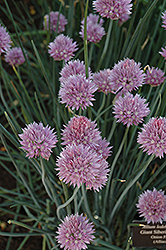Giant Siberian Chives
Allium ledebourianum
Plant Height: 24 inches
Flower Height: 3 feet
Spread: 24 inches
Sunlight:
![]()
![]()
Hardiness Zone: 2
Other Names: Flowering Onion
Description:
Pretty purple-pink ball flowers emerge in mid summer over fine blue green, grassy foliage; excellent for gardens and containers; impressive when massed along borders
Ornamental Features
Giant Siberian Chives has masses of beautiful balls of lavender flowers at the ends of the stems in mid summer, which are most effective when planted in groupings. Its fragrant grassy leaves remain bluish-green in color throughout the season.
Landscape Attributes
Giant Siberian Chives is an open herbaceous perennial with an upright spreading habit of growth. It brings an extremely fine and delicate texture to the garden composition and should be used to full effect.
This is a relatively low maintenance plant, and should only be pruned after flowering to avoid removing any of the current season's flowers. It is a good choice for attracting butterflies to your yard, but is not particularly attractive to deer who tend to leave it alone in favor of tastier treats. It has no significant negative characteristics.
Giant Siberian Chives is recommended for the following landscape applications;
- Mass Planting
- Rock/Alpine Gardens
- Border Edging
- General Garden Use
Planting & Growing
Giant Siberian Chives will grow to be about 24 inches tall at maturity extending to 3 feet tall with the flowers, with a spread of 24 inches. It grows at a medium rate, and under ideal conditions can be expected to live for approximately 5 years. As an herbaceous perennial, this plant will usually die back to the crown each winter, and will regrow from the base each spring. Be careful not to disturb the crown in late winter when it may not be readily seen! As this plant tends to go dormant in summer, it is best interplanted with late-season bloomers to hide the dying foliage.
This plant does best in full sun to partial shade. It does best in average to evenly moist conditions, but will not tolerate standing water. It is not particular as to soil type or pH, and is able to handle environmental salt. It is highly tolerant of urban pollution and will even thrive in inner city environments. This species is not originally from North America. It can be propagated by multiplication of the underground bulbs.
